Crockpot Corned Beef for Rosh a Shana
What is Brisket?
Brisket is interesting because two different groups can claim it as "their" dish; the Jews and the Texans. And I guess if you're a Jewish Texan you get double helpings. Down South brisket is usually slow cooked over indirect heat, with basting and smoking often involved. The brisket here is from the Jewish camp, with the meat being braised in the oven for a long time. It's a pot roast, essentially. Other cultures have their versions, too, and we could discuss them for a while, but this is not that kind of cookbook.
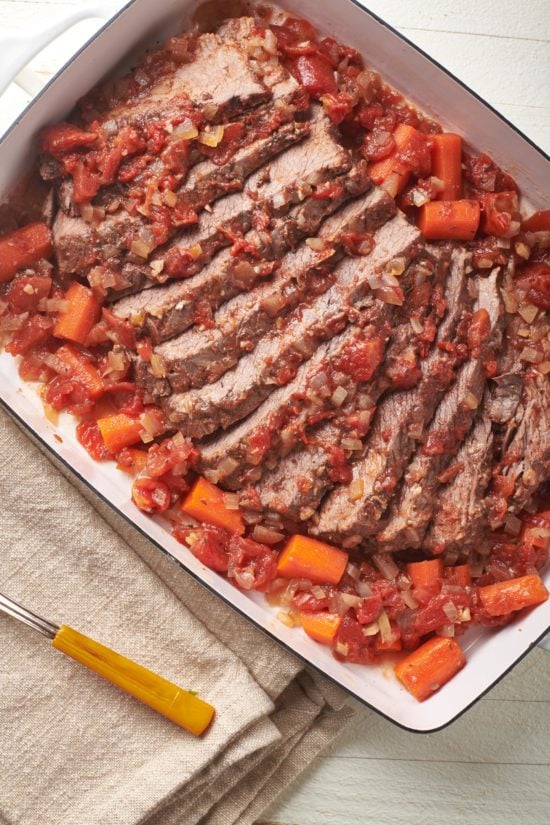
Jewish Brisket for Holidays (Rosh Hashana! Passover!), and More
Many of us think of brisket during the Jewish holidays, Rosh Hashana and Passover in particular, and rarely otherwise. But like potato pancakes my family is so crazy about brisket that it makes no sense not to make it all throughout the colder months. First, it's a pretty inexpensive cut of meat. Second, aside from acknowledging that it needs to cook for a few hours, it really takes little work. Don't you just love a main course that you can ignore?
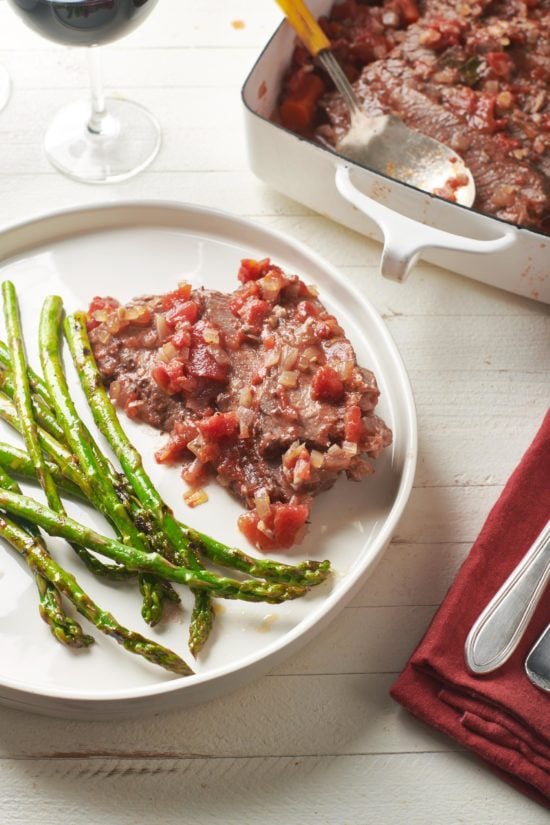
Some recipes call for browning the brisket first, which is a nice step if you have extra time on your hands (pause for laughter). But it's just not necessary for a nice tender brisket, and not only do you save the extra time, you also save having to clean up the splatters all over the stove (at least that's what Gary tells me). I'm usually taking one one too many dishes when I entertain, especially for the holidays, so I'm happy to let the oven do all the work here.
Make Ahead Jewish Brisket
There are a few reasons to make the brisket a day or two ahead of time. (1) It tastes better; the flavors really meld and blend and all of that stuff, and the meat is at its most tender. (2) Your life will be easier the next day because dinner is basically made. (3) You can skim off the fat from the cooking liquid, which will create a more concentrated cooking liquid with no greasiness. (4) It's much easier to slice the brisket when it's cold.
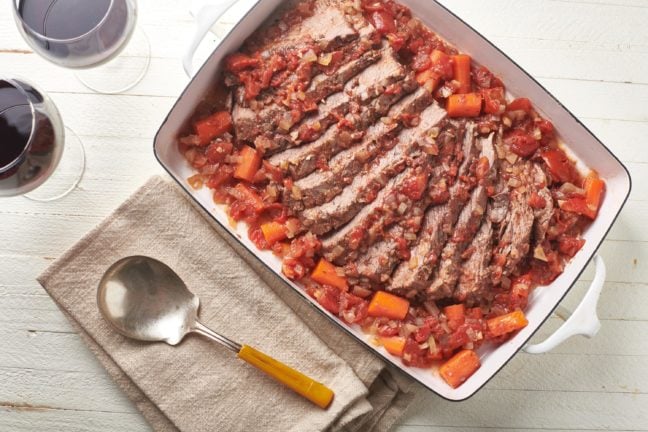
This was originally called Monday Night Brisket because it's the kind of dish you want to start early in the day, when you have a stretch of time, for example on a Sunday afternoon, and refrigerate overnight for the next night's dinner. Refrigerating it actually makes it so much easier to slices, and then you tuck the slices back into the sauce and reheat it at your leisure.
What Kind of Liquid to Cook Brisket In
You'll see that the brisket recipe calls for three liquids: broth, tomatoes, and wine. If you use only one or two of these, and just make the quantity equal to about 6 cups of liquid, the results will be fine. The tomato paste adds richness to the cooking liquid and is great, but if you don't have any, add some squirts of ketchup or skip it altogether. The reason brisket tastes so good is mostly because of its long slow cooking in liquid in the oven, and it's fairly magnanimous about what kind of liquid it is braised in.
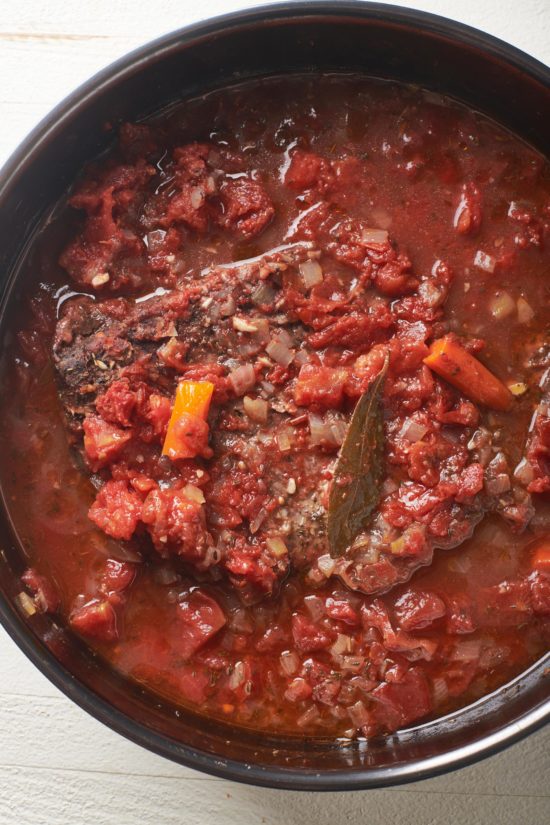
First-cut brisket means brisket with much of the fat cut off (but not all, you don't want that). If you get a bigger piece of meat and want to cut it into two pieces, you can overlap them in the pot. On the whole, brisket is fairly resilient.
Total Jewish comfort food (but don't feel like you have to be Jewish to make this).
Tweet This
What the Kids Can Do
The kids can peel carrots, if they can handle the peeler. They can also measure ingredients and add them to the pot with the brisket.
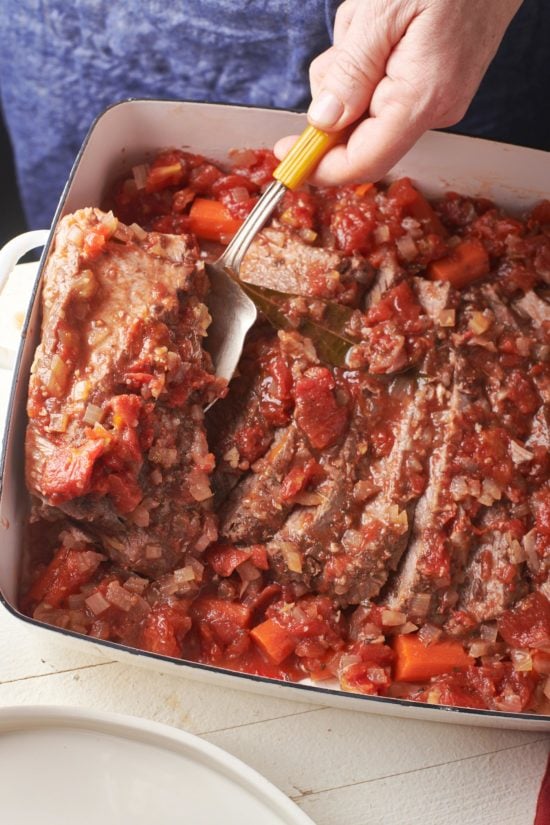
What to Serve with Jewish Brisket:
Pick and choose for a Rosh Hashana Menu.
- Herb Roasted Fingerling Potatoes
- Baby Romaine, Chickpea, and Root Vegetable Salad with Slightly Spicy Dressing
- Spinach, Radish, and Kohlrabi Salad with Preserved Lemons
- Chopped Winter Salad
- Romaine and Slivered Kale Salad with Lemon Dressing
- Endive, Arugula and Orange Salad
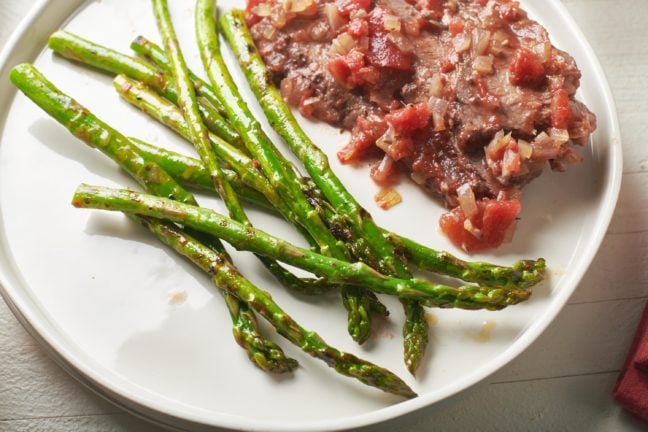
Other Jewish Holiday Main Course Options:
- Chicken Marbella
- Chicken Thighs with Onions and Green Olives
- Garlicky Roast Chicken with Shallots and Potatoes
- Beef Brisket with Wild Mushrooms (another Jewish-style brisket!)
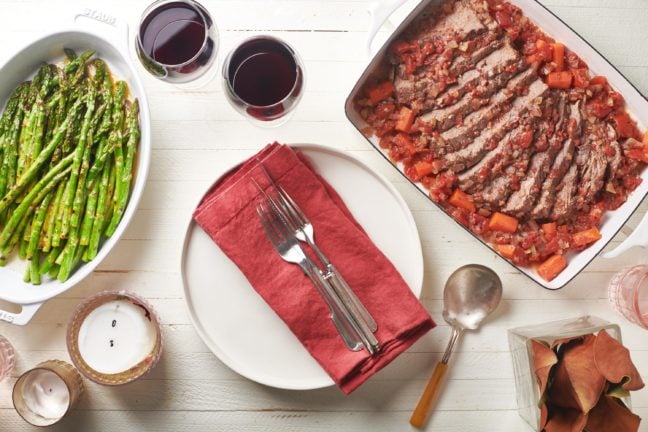
Like this recipe? Pin it to your favorite board on Pinterest.
Pin This
- 1 teaspoon olive oil
- 2 teaspoons minced garlic
- 1 teaspoon dried thyme
- ¼ teaspoon freshly ground black pepper
- 1 first-cut beef brisket 4 to 5 pounds
- 2 cups chopped onions
- 4 large carrots peeled and thickly sliced
- 3 bay leaves
- 3 tablespoons tomato paste optional; see the Cooking Tip
- 1 cup low-sodium beef or chicken broth
- 1 can (28 ounces) crushed tomatoes in juice or puréed
- 1 cup red wine any kind is fine, or an additional cup crushed tomatoes or broth
- 2 tablespoons finely chopped Italian flat-leaf parsley (optional), for garnish
- 1 teaspoon kosher or coarse salt
-
Preheat the oven to 325°F.
-
Place the olive oil, garlic, thyme, salt, and pepper in a small bowl and stir to mix. Rub the mixture all over.
-
Place the brisket, fat side up, in a large casserole or Dutch oven with a tight-fitting lid. Toss in the onions, carrots, and bay leaves. If you are using the tomato paste, blend it into the broth then pour over the meat and vegetables. Then pour the crushed tomatoes and red wine, if using, on top. The liquid should cover the meat and most of the vegetables. Cover the casserole and bake the brisket until the meat is very tender, 3 to 31⁄2 hours.
-
If you are serving the brisket the next day, let it cool then put the entire casserole in the refrigerator. About an hour before serving, skim off any hardened fat, then take out the meat and cut off any excess fat from the top of the meat. Slice the brisket across the grain, as thin or thick as you like, then neatly return the sliced meat to the cooking liquid. Reheat the brisket on the stovetop over medium-low heat, or in a preheated 325°F oven, until everything is warmed through and the cooking liquid has reduced and thickened up a bit, about 30 minutes in the oven, maybe less on the stovetop. Adjust seasonings as needed.
-
If you are serving the brisket right away, remove the meat from the casserole and let it rest on a platter, loosely tented with aluminum foil. Let the cooking liquid and vegetables sit for about 15 minutes, then spoon off any fat that has accumulated. Place the casserole over medium-high heat and simmer, stirring occasionally, until the liquid reduces a bit, about 10 minutes. Adjust seasonings as necessary. Slice the meat neatly across the grain, return it to the pot, and remove and discard the bay leaves.
-
You can serve the brisket in the casserole or transfer it to a large shallow bowl. Remove and discard the bay leaves and sprinkle the parsley on top of the brisket, if desired.
Cooking Tip #1
You'll see that the brisket recipe calls for three liquids: broth, tomatoes, and wine. If you use only one or two of these, and just make the quantity equal to about 6 cups of liquid, the results will be fine. The tomato paste adds richness to the cooking liquid and is great, but if you don't have any, add some squirts of ketchup or skip it altogether. The reason brisket tastes so good is mostly because of its long slow cooking in liquid, and it's fairly magnanimous about what kind of liquid it is braised in.
Calories: 362.76 kcal | Carbohydrates: 13.3 g | Protein: 40.25 g | Fat: 14.27 g | Saturated Fat: 4.86 g | Cholesterol: 112.49 mg | Sodium: 545.37 mg | Potassium: 1060 mg | Fiber: 3 g | Sugar: 6.79 g | Vitamin A: 4387.52 IU | Vitamin C: 13.41 mg | Calcium: 59.2 mg | Iron: 5.13 mg
The nutrition values are provided as an estimate. It is not intended as a substitute for the advice of a qualified healthcare professional.
Made this recipe? Post a photo of your delicious creation on Instagram with our hashtag #dinnersolved
Source: https://themom100.com/recipe/jewish-brisket-for-the-holidays/
0 Response to "Crockpot Corned Beef for Rosh a Shana"
Post a Comment